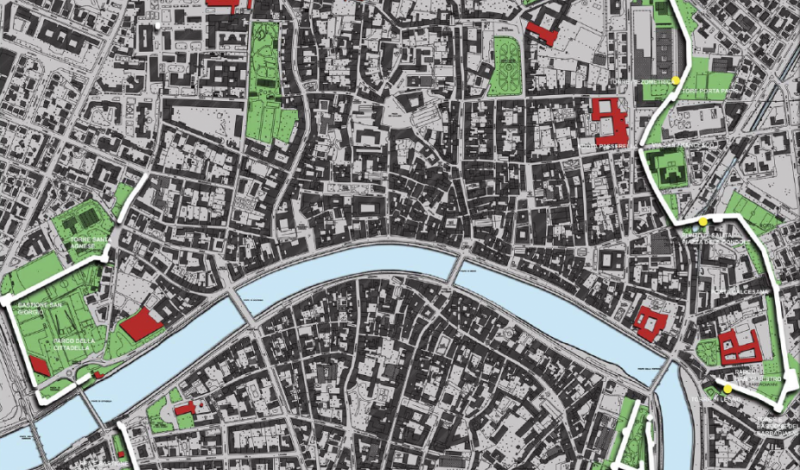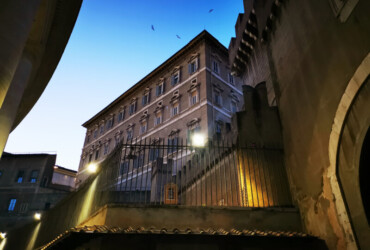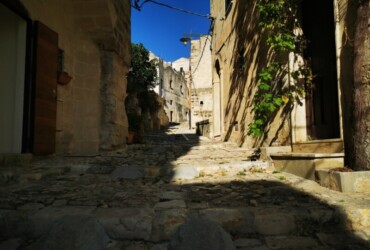In mid-March, I was in Pisa with the Italian Travel Blogger Association, for the annual assembly and a beautiful tour of the city. I begin to tell you the two days from the walk made along the walkway of the walls of Pisa and the visit to the monuments of Piazza dei Miracoli.
 We started our tour of Pisa and some of its most important monuments from Saturday afternoon together with the architect Marco Guerrazzi (manager of the City of Pisa), who took us along the walls, while he told us about the excellent restoration work that he saw them as protagonists. The construction of the walls, which began north of the Arno, lasted from 1154 to 1186 although it was later extended for more than a century because towers and dams were built (in addition to the elevation of some parts).
We started our tour of Pisa and some of its most important monuments from Saturday afternoon together with the architect Marco Guerrazzi (manager of the City of Pisa), who took us along the walls, while he told us about the excellent restoration work that he saw them as protagonists. The construction of the walls, which began north of the Arno, lasted from 1154 to 1186 although it was later extended for more than a century because towers and dams were built (in addition to the elevation of some parts).
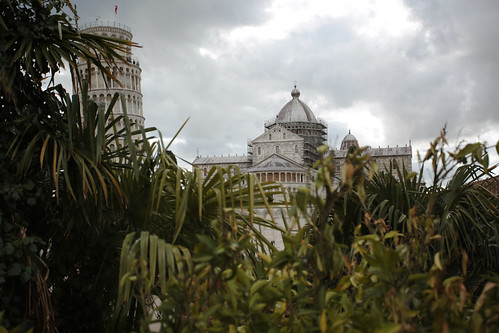 We also know that some further interventions, such as the construction of the New Citadel, were made between the fifteenth and sixteenth centuries. Also, the structure of the walls remained virtually unchanged until the nineteenth century, and the city remained within them until more than half of the same century. Speaking of the present day, the restoration of the walls has become an instrument to safeguard what has remained intact over the centuries and to redevelop what is, in effect, a significant city monument. The walk we took along the walkway, took us from the access point in the locality “Le Gondole” to Piazza dei Miracoli along a path of about a mile. The view of the city from above is beautiful; the walkway allows you to see Pisa from a different point of view and the views to photograph are endless.
We also know that some further interventions, such as the construction of the New Citadel, were made between the fifteenth and sixteenth centuries. Also, the structure of the walls remained virtually unchanged until the nineteenth century, and the city remained within them until more than half of the same century. Speaking of the present day, the restoration of the walls has become an instrument to safeguard what has remained intact over the centuries and to redevelop what is, in effect, a significant city monument. The walk we took along the walkway, took us from the access point in the locality “Le Gondole” to Piazza dei Miracoli along a path of about a mile. The view of the city from above is beautiful; the walkway allows you to see Pisa from a different point of view and the views to photograph are endless.
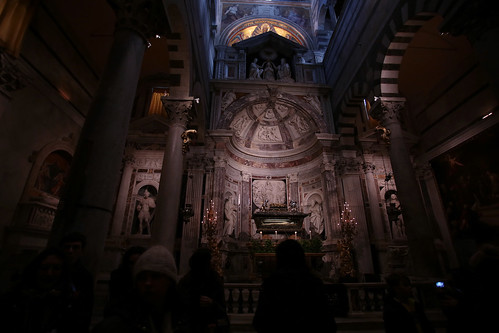 After descending from the walls in Piazza dei Miracoli, we went to discover the monuments of the square together with Francesca Ughi (highly trained guide of PisaGuide.com). We start the tour from the Cathedral, a primatial church built in the Middle Ages. The construction works began in 1063, followed by the architect Buscheto, and already from the outside, we can see how different styles were used (classical, Lombard-Emilian, Byzantine and in particular Islamic). As a cathedral, it became a primatial church in 1092, and inside it, a chapel on the right of the altar is the tomb of San Ranieri: a hermit who was sanctified by the Catholic Church and today is the patron saint of the city. On 16 June each year, there is the
After descending from the walls in Piazza dei Miracoli, we went to discover the monuments of the square together with Francesca Ughi (highly trained guide of PisaGuide.com). We start the tour from the Cathedral, a primatial church built in the Middle Ages. The construction works began in 1063, followed by the architect Buscheto, and already from the outside, we can see how different styles were used (classical, Lombard-Emilian, Byzantine and in particular Islamic). As a cathedral, it became a primatial church in 1092, and inside it, a chapel on the right of the altar is the tomb of San Ranieri: a hermit who was sanctified by the Catholic Church and today is the patron saint of the city. On 16 June each year, there is the
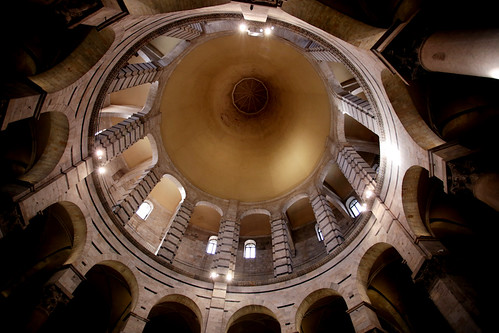 “Luminara di San Ranieri” (for the festivity of the city patron). Opposite the cathedral, there is the Baptistery, whose construction was begun in the mid-twelfth century (the foundation dates back to 1152, although it took more than two centuries to complete the entire building). With a circumference of 107.24 m, a height of 54 meters and 86 cm and a base masonry of two meters and 63 cm this is the largest baptistery in Italy and Europe. In the nineteenth century, for a renewal of the entire Piazza, the baptistery was restored by architect Alessandro Gherardesca (he also rebuilt some portals and decorations). Unfortunately, almost all the original sculptures have been lost, apart from those that you can see in the
“Luminara di San Ranieri” (for the festivity of the city patron). Opposite the cathedral, there is the Baptistery, whose construction was begun in the mid-twelfth century (the foundation dates back to 1152, although it took more than two centuries to complete the entire building). With a circumference of 107.24 m, a height of 54 meters and 86 cm and a base masonry of two meters and 63 cm this is the largest baptistery in Italy and Europe. In the nineteenth century, for a renewal of the entire Piazza, the baptistery was restored by architect Alessandro Gherardesca (he also rebuilt some portals and decorations). Unfortunately, almost all the original sculptures have been lost, apart from those that you can see in the
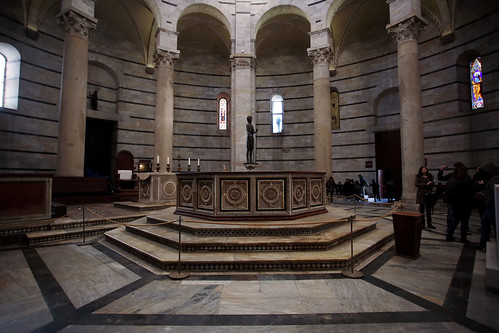 museum (Museo dell’Opera del Duomo). The Baptismal Font, in which the baptisms are made by immersion, was created by Guido da Como and is located in the centre of the building: in my opinion spectacular work. The pulpit is the work of Nicola Pisano, father of Giovanni Pisano, built between 1255 and 1260. The most peculiar aspect of the baptistery is its roofing system, made with a double covering: this makes the acoustics of the baptistery very special (every 30 minutes, the surveillance personnel make short vocal pitches so that visitors can hear the echo).
museum (Museo dell’Opera del Duomo). The Baptismal Font, in which the baptisms are made by immersion, was created by Guido da Como and is located in the centre of the building: in my opinion spectacular work. The pulpit is the work of Nicola Pisano, father of Giovanni Pisano, built between 1255 and 1260. The most peculiar aspect of the baptistery is its roofing system, made with a double covering: this makes the acoustics of the baptistery very special (every 30 minutes, the surveillance personnel make short vocal pitches so that visitors can hear the echo).
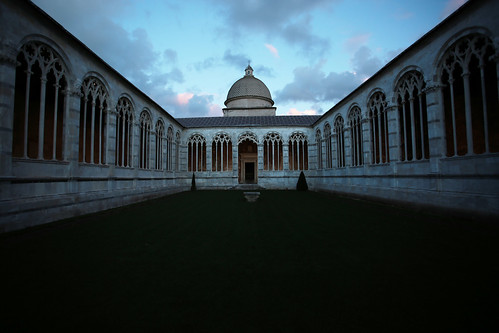 Lastly, we visit the Pisa monumental cemetery, which I have long wanted to visit (but never succeeded, unfortunately). Started in 1277 by Giovanni di Simone, it is the monumental cemetery of Pisa and extends along the north side of the square. Inside the graveyard are preserved some rings of the great chain of the Port of Pisa that was broken after the defeat in the battle of Meloria. A first part “returned” to Pisa in 1848 when they were given back to the city by the Florentines (who received it from the Genoese). The rightmost part was given back to the town by the Genovese in 1860.
Lastly, we visit the Pisa monumental cemetery, which I have long wanted to visit (but never succeeded, unfortunately). Started in 1277 by Giovanni di Simone, it is the monumental cemetery of Pisa and extends along the north side of the square. Inside the graveyard are preserved some rings of the great chain of the Port of Pisa that was broken after the defeat in the battle of Meloria. A first part “returned” to Pisa in 1848 when they were given back to the city by the Florentines (who received it from the Genoese). The rightmost part was given back to the town by the Genovese in 1860.
 Inside the cemetery, there are numerous frescoes made by different artists (such as Buffalmacco, Andrea Bonaiuti, Antonio Veneziano, Spinello Aretino, Taddeo Gaddi, Piero di Puccio): in 1944 they ended up destroyed or damaged due to an allied bombing that caused a fire of the cemetery itself. When the frescoes for the restoration were removed, the Sinopias (i.e. the preparatory drawings of the murals) came to light: these drawings are now in the Sinopie museum.
Inside the cemetery, there are numerous frescoes made by different artists (such as Buffalmacco, Andrea Bonaiuti, Antonio Veneziano, Spinello Aretino, Taddeo Gaddi, Piero di Puccio): in 1944 they ended up destroyed or damaged due to an allied bombing that caused a fire of the cemetery itself. When the frescoes for the restoration were removed, the Sinopias (i.e. the preparatory drawings of the murals) came to light: these drawings are now in the Sinopie museum.
I close this post thanking all those who have contributed to this weekend:
the municipality of Pisa, for its patronage;
the Ship Museum and the Opera Primaziale Pisana, which allowed us to visit some beautiful places (the monuments of Piazza dei Miracoli and the museum of the Ancient Ships of Pisa
PisaGuide.com and Francesca Ughi for the guided tour of the pillars of Piazza dei Miracoli. And finally, thank you, of course, also the restaurants that have hosted and refreshed us during the two days in the city:
Spaghetteria Ir Tegame;
Osteria del Violino;
Typical Restaurant Il Turista
Of course, we can not fail to thank the Grand Hotel Duomo, where we slept.
Pisa: walk around the walls of Pisa and Piazza dei Miracoli
